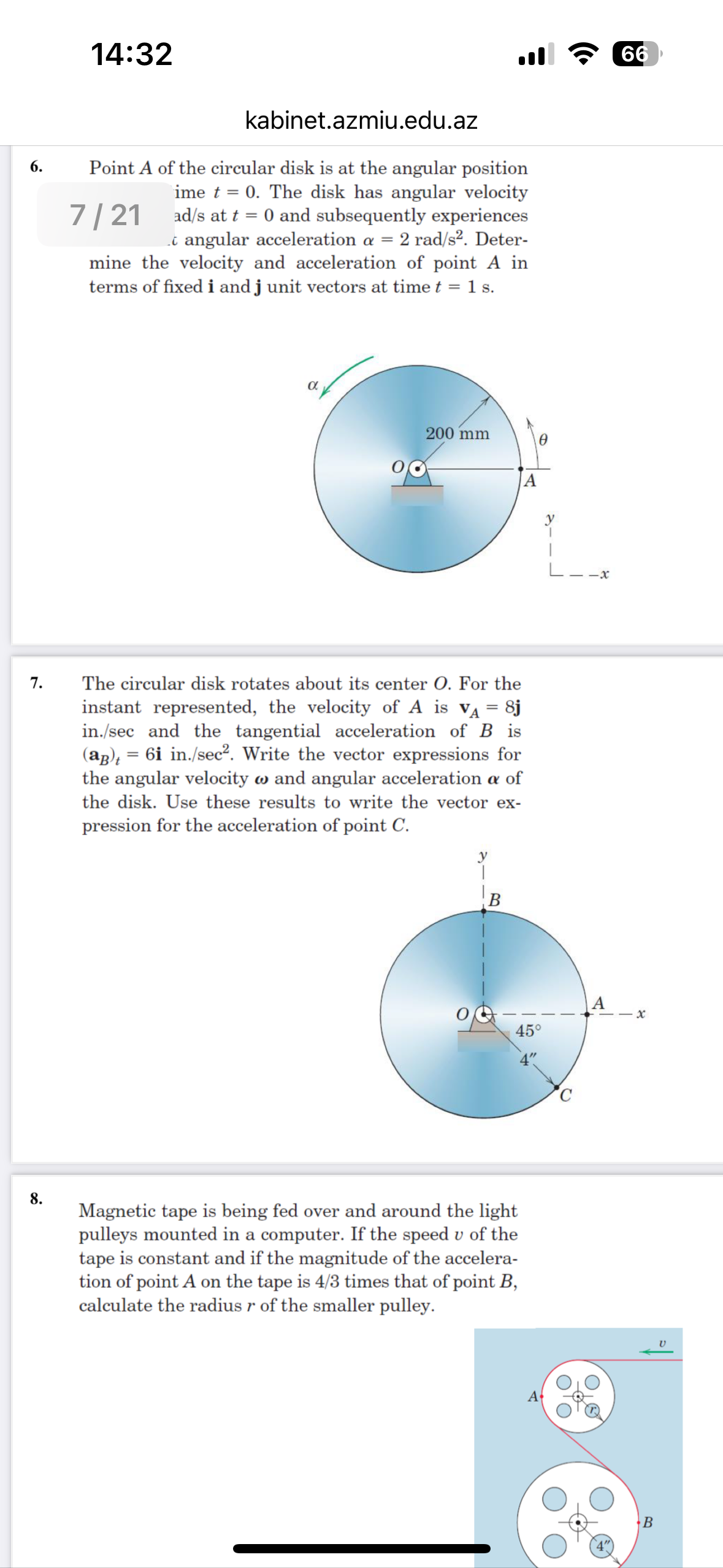Point A of the circular disk is at the angular position θ at time t = 0. The disk has angular velocity ω = 4 rad/s at t = 0 and experiences angular acceleration α = 2 rad/s². Deter... Point A of the circular disk is at the angular position θ at time t = 0. The disk has angular velocity ω = 4 rad/s at t = 0 and experiences angular acceleration α = 2 rad/s². Determine the velocity and acceleration of point A in terms of fixed i and j unit vectors at time t = 1 s.

Understand the Problem
The question addresses the dynamics of a circular disk in terms of angular motion. It specifically asks for the velocity and acceleration of a given point on the disk at a certain time, requiring the use of angular velocity and acceleration equations. The overall aim is to analyze the motion of point A given the initial conditions and the changes due to angular acceleration.
Answer
Velocity: $$ \vec{v_A} = 1.2 \begin{pmatrix} \cos(\theta) \\ \sin(\theta) \end{pmatrix} $$ Acceleration: $$ \vec{a_A} = 0.4 \begin{pmatrix} \cos(\theta) \\ \sin(\theta) \end{pmatrix} + 7.2 \begin{pmatrix} -\sin(\theta) \\ \cos(\theta) \end{pmatrix} $$
Answer for screen readers
The velocity of point A at $t=1$ s is given by:
$$ \vec{v_A} = 1.2 \begin{pmatrix} \cos(\theta) \ \sin(\theta) \end{pmatrix} $$
The acceleration of point A at $t=1$ s is:
$$ \vec{a_A} = 0.4 \begin{pmatrix} \cos(\theta) \ \sin(\theta) \end{pmatrix} + 7.2 \begin{pmatrix} -\sin(\theta) \ \cos(\theta) \end{pmatrix} $$
Steps to Solve
- Determine the angular velocity at time t = 1 s
To find the angular velocity at time $t = 1 \text{ s}$, we use the equation:
$$ \omega(t) = \omega_0 + \alpha t $$
where
$\omega_0 = 4 , \text{rad/s}$ (initial angular velocity)
$\alpha = 2 , \text{rad/s}^2$ (angular acceleration)
Substituting the values:
$$ \omega(1) = 4 + 2(1) = 6 , \text{rad/s} $$
- Calculate the tangential velocity of point A
The tangential velocity ($v_t$) at a radius $r$ is given by:
$$ v_t = r \omega $$
Given that the radius ( r = 0.2 , \text{m} ) (200 mm), we find:
$$ v_t = 0.2 \times 6 = 1.2 , \text{m/s} $$
- Express the velocity vector in terms of unit vectors
Since point A starts at angle $\theta$ and moves with angular velocity, we can express the final position in unit vectors:
$$ \vec{v_A} = v_t \begin{pmatrix} \cos(\theta) \ \sin(\theta) \end{pmatrix} $$
At $t=1s$, with $\theta$ determined, the velocity is:
$$ \vec{v_A} = 1.2 \begin{pmatrix} \cos(\theta) \ \sin(\theta) \end{pmatrix} $$
- Calculate the centripetal acceleration
The centripetal acceleration ($a_c$) is given by:
$$ a_c = \frac{v_t^2}{r} $$
Substituting values:
$$ a_c = \frac{(1.2)^2}{0.2} = 7.2 , \text{m/s}^2 $$
- Calculate the total acceleration of point A
The total acceleration ($\vec{a_A}$) consists of tangential acceleration ($a_t$) and centripetal acceleration ($a_c$):
$$ a_t = r \alpha = 0.2 \times 2 = 0.4 , \text{m/s}^2 $$
The total acceleration vector is:
$$ \vec{a_A} = \begin{pmatrix} \cos(\theta) \ \sin(\theta) \end{pmatrix} a_t + \begin{pmatrix} -\sin(\theta) \ \cos(\theta) \end{pmatrix} a_c $$
Substituting values:
$$ \vec{a_A} = 0.4 \begin{pmatrix} \cos(\theta) \ \sin(\theta) \end{pmatrix} + 7.2 \begin{pmatrix} -\sin(\theta) \ \cos(\theta) \end{pmatrix} $$
The velocity of point A at $t=1$ s is given by:
$$ \vec{v_A} = 1.2 \begin{pmatrix} \cos(\theta) \ \sin(\theta) \end{pmatrix} $$
The acceleration of point A at $t=1$ s is:
$$ \vec{a_A} = 0.4 \begin{pmatrix} \cos(\theta) \ \sin(\theta) \end{pmatrix} + 7.2 \begin{pmatrix} -\sin(\theta) \ \cos(\theta) \end{pmatrix} $$
More Information
This problem illustrates how to analyze the motion of a point on a rotating disk by applying the concepts of angular velocity, tangential velocity, and centripetal acceleration. The importance of distinguishing between linear and angular quantities is emphasized.
Tips
- Forgetting to convert units (e.g., mm to meters).
- Mixing up tangential and centripetal acceleration.
- Not properly applying trigonometric functions based on the angle.
AI-generated content may contain errors. Please verify critical information